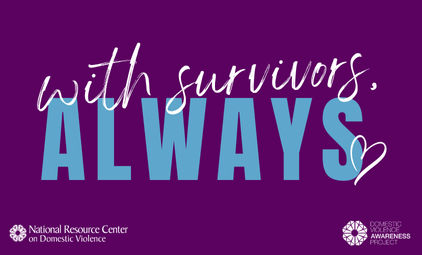Thanks to concerned activism, including a flurry of creative social media efforts, domestic violence advocates across the country are getting the buzz about this year’s National Women and Girls HIV/AIDS Awareness Day. Given advocates’ interest in observing the day (March 10, 2013), requests for additional information on the connection between intimate partner violence and HIV/Aids have increased. Research highlights and resources are included here to provide advocates with information and tools to more effectively address the co-occurrence of domestic violence and HIV/AIDS.
IPV as a risk factor for HIV
 Although the prevalence of intimate partner violence (IPV) and HIV infection among women varies globally, females remain at increased risk for both IPV and sexually transmitted/HIV infection (Campbell et al., 2008). In the United States, a review of the literature on the link between IPV and the risk of HIV transmission among women indicates that experiencing IPV may increase a woman’s risk for HIV. The reasons are multi-fold:
Although the prevalence of intimate partner violence (IPV) and HIV infection among women varies globally, females remain at increased risk for both IPV and sexually transmitted/HIV infection (Campbell et al., 2008). In the United States, a review of the literature on the link between IPV and the risk of HIV transmission among women indicates that experiencing IPV may increase a woman’s risk for HIV. The reasons are multi-fold:
- Abuse and fear of abuse may impact a woman’s ability to successfully negotiate condom use, which may increase her risk for heterosexually transmitted HIV from an HIV-positive partner. A study involving domestic violence shelter residents found that women who did not consistently use condoms during sexual intercourse often reported that their partner refused to use a condom when they asked him to do so (Bocanegra et al., 2010). In another study, men who perpetrate physical violence toward their female partner were found to be half as likely to report consistent condom use as men who do not report using violence (Frye et al., 2011).
- Moreover, a large proportion of women in abusive relationships report experiencing forced sex. In a study involving 53 domestic violence survivors residing at shelters, two thirds of the sample (35, or 66%) reported having been forced to have sex by their abusive partner. Some of the women added that they received threats of having their kids taken away or not getting food if they did not comply with their partners’ sexual wishes (Bocanegra et al., 2010)
- It is also know that for some women in abusive relationships, the partner’s coercion and control includes forcing her to engage in other risky behaviors, such as illicit drug use and sex work, both of which carry substantial HIV risk (Gielen et al., 2007).
The twin pandemics of violence against women (VAW) and HIV/AIDS are each rooted in gender discrimination, women’s subordination, disregard for women’s human rights, and the power imbalances between women and men that exist in societies all over the world.” (UN Women, 2012)
HIV status as a risk factor for further abuse
Conversely, survivors of IPV who are HIV-positive may be at increased risk for subsequent abuse when their HIV status is disclosed, including specific HIV-related tactics of abuse (NCAVP, 2012). Abusive partners can use survivor’s HIV-status as a tool to maintain power and control by:
- Withholding or threatening to withhold medication
- Interfering with HIV-related medical appointments
- Increasing physical violence when HIV-positive survivors are physically-ill
- Inflicting HIV-related emotional abuse such as threatening to out an HIV-positive survivor’s status or trying to shame them because of having HIV
I don’t want to continue a marriage where he’s gonna, you know, stressing me out so bad that my immune system gonna break and I’m going to get sick.” – IPV survivor diagnosed with nonsymptomatic HIV (Thomas et al., 2008)
These abusive tactics can substantially reduce the physical and mental health of HIV-affected survivors. Abuse survivors living with serious health conditions such as HIV/AIDS have linked the stress from the abuse to compromised immune systems, lowered blood counts, and increased sicknesses (Thomas et al., 2008).
Recommendations and tools for advocates
Given the close link between IPV and HIV/AIDS, it is clear that effective policies, prevention and intervention efforts must acknowledge IPV as a risk factor for HIV/AIDS. At the same time, HIV prevention efforts directed at victims and perpetrators of IPV is also critical. To assist in the development of processes for integrating HIV and violence against women interventions, UNIFEM and Development Connections published a Manual for Integrating the Programmes and Services of HIV and Violence Against Women. Guidelines for Integrating Domestic Violence Screening into HIV Counseling, Testing, Referral & Partner Notification are available from the New York State Department of Health. Also available are examples of programs designed to support people living with HIV and STD’s by notifying their partners that they should be tested and linking those partners to testing and treatment. For domestic violence advocates seeking to raise awareness and develop educational materials for use within their programs, A Guide to Developing Materials on HIV/AIDS and STIs may be of assistance. The importance of raising awareness and providing education around the intersection of HIV/AIDS and violence against women cannot be overstated. For ideas on how to take action on this vitally important issue, please check out VAWnet’s National Women and Girls HIV/AIDS Awareness Day blog post highlighting opportunities for participation from the NRCDV.
What are you doing in your community to share knowledge and take action on the intersection of HIV/AIDS and violence against women? Share your activities with us!
















